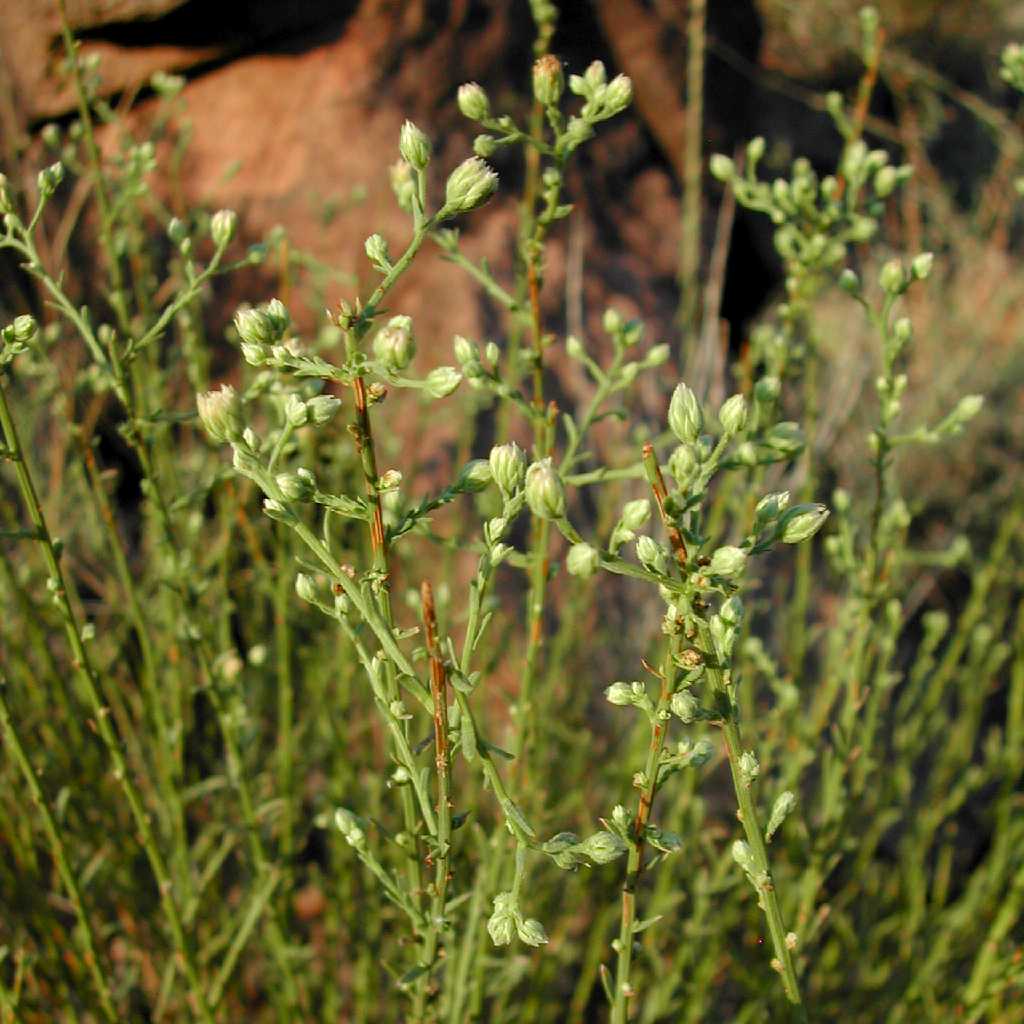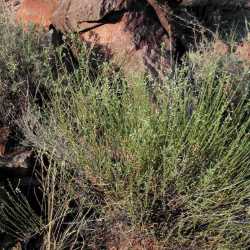|
|
|
|
Family: Asteraceae
shortleaf baccharis
|
Shrubs or subshrubs, 20-100 cm (finely and densely branched from bases). Stems erect, green, slender and wandlike, striate-angled, glabrate proximally, hispidulous distally (near heads). Leaves present at flowering (reduced , sparse); sessile; blades (1-nerved) linear to linear-lanceolate, 5-17 × 1-2 mm (reduced distally to subulate bracts), margins entire, apices acute, faces glabrous (sometimes minutely papillose). Heads (on racemiform lateral branches) in paniculiform arrays. Involucres funnelform or campanulate; staminate 3-5.2 mm, pistillate 4-6 mm. Phyllaries lanceolate, 1-4 mm, margins scarious, medians green (hispid), apices acute to acuminate. Staminate florets (8-)12-18(-29); corollas 3.3-4.2 mm. Pistillate florets 8-18; corollas 2-2.8 mm. Cypselae 1.5-2.5 mm, 5-nerved, hispid; pappi 4.5-7 mm. 2n = 18. Flowering Jul-Aug. Canyons, dry washes, sandy deserts, mesas; 300-1200 m; Ariz., Calif., Nev., N.Mex., Tex.; Mexico (Baja California, Chihuahua, Sonora). Baccharis brachyphylla is characterized by the densely branching habit, narrow stems, and small, linear-lanceolate leaves, and hispidulous hairs on stems, leaves, phyllaries, and cypselae.
Wiggins 1964, FNA 2006, Benson and Darrow 1981, Kearney and Peebles 1969 Common Name: shortleaf baccharis Duration: Perennial Nativity: Native Lifeform: Subshrub General: Much branched shrub or subshrub, 20-100 cm tall; stems slender, lightly striate, pale green or slightly grayish due to a covering of short spreading hairs; many of the hairs gland-tipped. Leaves: Alternate and sessile; blades linear, acute-tipped, 1 mm wide, 0.5 to 1 cm long; the upper leaves reduced to scalelike bracts often less than 5 mm long. Flowers: Flower heads unisexual, discoid, arranged short terminal racemes; involucre (the ring of bracts surrounding the flower head) bell shaped to funnel shaped, 3-5 mm high, the bracts (phyllaries) ovate to oblong-lanceolate, pale greenish and puberulent along midrib, with scarious margins. Staminate florets 3-4 mm, all discs, with yellowish corollas; pistillate florets 2-3 mm, all discs, with white corollas. Fruits: Achenes brownish, about 2 mm long, puberulent between 5 ribs, with a pappus of rusty or tawny-colored bristles, 6-8 mm long. Ecology: Found on alluvial plains and slopes with well drained soils, from 1,500-4,000 ft (457-1219 m); flowers May-November. Distribution: CA and NV, east to TX; south to n MEX (Baja California, Chihuahua, Sonora). Notes: Baccharis is a genus of shrubs with male and female flowers on separate plants, gland-dotted leaves, all disc flowers, and a pappus of bristles on the seeds. B. brachyphylla is characterized by its short stature (usually < 60 cm); densely branching growth form that looks similar to Ephedra; striate, bright green stems with hispidulous hairs (the short hairs just visible with a hand lens); and scale-like leaves less than 1 cm long that tend to be appressed to the stems and covered with glandular hairs (the glandular hairs often difficult to see using a hand lens); and a growth form which is not particularly broom-like, with the smaller twigs and flower stalks somewhat spreading from the larger branches. B. sarothroides is a larger, woodier plant often 2 m or more tall, with a strongly broom-like growth form (smaller branches are appressed against the larger branches they emerge from); the leaves, when present are usually more than 1 cm long, but are more often absent; and stems and leaves are essentially hairless. Ethnobotany: Unknown, but other species in this genus have many uses. Etymology: Baccharis is named for Bacchus, the god of wine, while brachyphylla means short-leaved. Synonyms: None Editor: SBuckley 2010, AHazelton 2015 |
|
|
|




